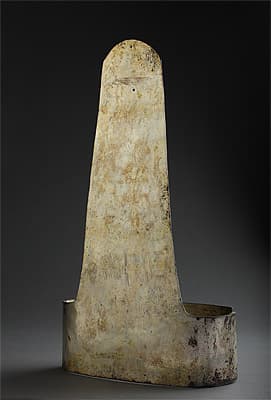
VICÚS culture North coast 100 BC – 400 AD
Crown 100 BC - 400 AD gold and copper , rolling, contouring, gilding47.2 (h) x 26.2 (w) x 14.8 (d) cm Museo Oro del Perú, Lima Photograph: Daniel Giannoni
Both the Vicús crowns feature a central or double plume with rounded tip, made of foil-gilded copper. The stylised projections widen at the base to form the band that sits around the wearer’s forehead and connects at the back. The crown with the single central plume has three discrete holes, through which an additional adornment would have been attached. The pectoral (cat. 28) similarly has two holes at the top, in the centre of the top ‘V’, to anchor it to a tunic.1
The stark bold shapes of the large nose ring and pectoral (cats 27, 28) complement the form of the crown. They are also similar to one another, as both are shaped in a distinctive simple ‘V’. However, the nose ornament has a small circular notch in the top centre of the ‘V’—the ornament would have hung from the wearer’s nose through this notch. Like the crowns, the pectoral and nose ring are constructed from flat sheets of gold-coated copper.
Although Vicús regalia of this kind lacks the decorative elements of Moche counterparts, the visual effect is nonetheless balanced and harmonious. What sets Vicús adornment apart was the culture’s effective use of electroplating techniques. This meant that most of their metalware was gilt copper, with only an extremely thin layer of gold covering the surface of the copper object—in fact, the layers of gold are only 0.008 millimetres thick.2 Nonetheless, Vicús artisans produced strikingly large sculptural items of jewellery with the appearance of pure gold. This was achieved by submerging the object to be gilded in a solution of gold and other corrosive minerals that was heated to between 500 and 800oC.
Simeran Maxwell
1. Antonio Aimi, cat. 10, in L’oro del Perú, Milan: Electra 2007, p. 124.
2. Krzysztof Makowski et al., Vicus, Lima: Banco de Crédito del Perú 1994, p. 186.
Both the Vicús crowns feature a central or double plume with rounded tip, made of foil-gilded copper. The stylised projections widen at the base to form the band that sits around the wearer’s forehead and connects at the back. The crown with the single central plume has three discrete holes, through which an additional adornment would have been attached. The pectoral (cat. 28) similarly has two holes at the top, in the centre of the top ‘V’, to anchor it to a tunic.1
The stark bold shapes of the large nose ring and pectoral (cats 27, 28) complement the form of the crown. They are also similar to one another, as both are shaped in a distinctive simple ‘V’. However, the nose ornament has a small circular notch in the top centre of the ‘V’—the ornament would have hung from the wearer’s nose through this notch. Like the crowns, the pectoral and nose ring are constructed from flat sheets of gold-coated copper.
Although Vicús regalia of this kind lacks the decorative elements of Moche counterparts, the visual effect is nonetheless balanced and harmonious. What sets Vicús adornment apart was the culture’s effective use of electroplating techniques. This meant that most of their metalware was gilt copper, with only an extremely thin layer of gold covering the surface of the copper object—in fact, the layers of gold are only 0.008 millimetres thick.2 Nonetheless, Vicús artisans produced strikingly large sculptural items of jewellery with the appearance of pure gold. This was achieved by submerging the object to be gilded in a solution of gold and other corrosive minerals that was heated to between 500 and 800oC.
Simeran Maxwell
1. Antonio Aimi, cat. 10, in L’oro del Perú, Milan: Electra 2007, p. 124.
2. Krzysztof Makowski et al., Vicus, Lima: Banco de Crédito del Perú 1994, p. 186.
Both the Vicús crowns feature a central or double plume with rounded tip, made of foil-gilded copper. The stylised projections widen at the base to form the band that sits around the wearer’s forehead and connects at the back. The crown with the single central plume has three discrete holes, through which an additional adornment would have been attached. The pectoral (cat. 28) similarly has two holes at the top, in the centre of the top ‘V’, to anchor it to a tunic.1
The stark bold shapes of the large nose ring and pectoral (cats 27, 28) complement the form of the crown. They are also similar to one another, as both are shaped in a distinctive simple ‘V’. However, the nose ornament has a small circular notch in the top centre of the ‘V’—the ornament would have hung from the wearer’s nose through this notch. Like the crowns, the pectoral and nose ring are constructed from flat sheets of gold-coated copper.
Although Vicús regalia of this kind lacks the decorative elements of Moche counterparts, the visual effect is nonetheless balanced and harmonious. What sets Vicús adornment apart was the culture’s effective use of electroplating techniques. This meant that most of their metalware was gilt copper, with only an extremely thin layer of gold covering the surface of the copper object—in fact, the layers of gold are only 0.008 millimetres thick.2 Nonetheless, Vicús artisans produced strikingly large sculptural items of jewellery with the appearance of pure gold. This was achieved by submerging the object to be gilded in a solution of gold and other corrosive minerals that was heated to between 500 and 800oC.
Simeran Maxwell
1. Antonio Aimi, cat. 10, in L’oro del Perú, Milan: Electra 2007, p. 124.
2. Krzysztof Makowski et al., Vicus, Lima: Banco de Crédito del Perú 1994, p. 186.

